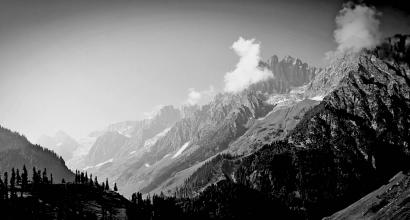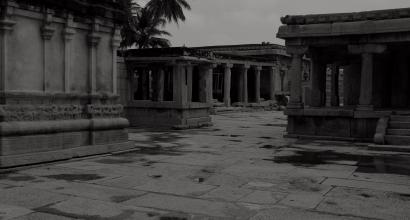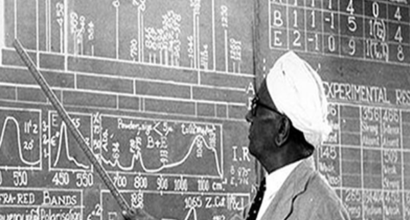This final chapter was the formation of the constitutional Reforms Committee on 1 April 1938 by the Mysore Government. The Committee itself was the outcome of a series of agitations by the Mysore unit of the Congress Party to usher in Responsible Government. It was simultaneously another ruse of Diwan Mirza Ismail to curb the growing power of the Congress in Mysore. The wording of the Government order that established this Committee did not mention the words “Responsible Government” as the ultimate objective of the Reforms Committee. Expectedly, the Mysore Congress hit back claiming[1] that the Committee was mere “political tinkering and as an attempt to stop recent political agitation without giving anything away.”
Mirza Ismail’s long relationship with the Indian National Congress was dichotomous. He was one of the staunchest admirers of Mohandas Gandhi. In April 1927, when Gandhi embarked on a tour of South India, Mirza made intricate arrangements for his stay in Nandi Hills for two months. During the course of their interactions, Mirza was suitably impressed by Gandhi’s advocacy of Khadi and later set up the Khadi industry in the Mysore State. It was the beginning of a long friendship. Mirza had earned the twin displeasure of the Mysore Maharaja and the British Government for entertaining Gandhiji as a state guest. Over time, Mirza also developed a similar level of friendship with other national Congress leaders like Sardar Patel, Acharya Kriplani, and Jawaharlal Nehru.
However, his relationship with the Mysore unit of the Congress was almost the exact opposite. From the start, Mirza felt that the Congress here was overreaching its boundaries through incessant agitations and making unreasonable demands on the Government. On its part, the national leadership of the Congress Party took whimsical stances with regard to its policy towards princely states. Its stated policy was one of non-interference. However, on various occasions, Gandhi would overrule this policy and issue shocking proclamations and condemnations[2] about certain princely states. Even as Gandhi’s 1927 visit to Mysore had charged up the local Congress, his statement in 1933 dealt a big blow. The All India Congress Committee (AICC) in Calcutta that year passed a resolution expressing its unstinted support to Congress units in all princely states. However, with regard to Mysore, Gandhi condemned the resolution itself. With that, the Mysore Congress was thoroughly demoralized.
However, the Government of India Act of 1935 completely changed the equation. In one stroke, Congress Party activists and freedom fighters got a firsthand taste of wielding political power albeit with constraints. A bicameral system was introduced in the British-ruled provinces of Bombay, Madras, Bengal, Assam, Bihar and United Provinces. It was a tremendous success for the Congress Party. Quite naturally, the fire spread to the Mysore unit which began demanding Responsible Government with greater agitational fervor. By 1937, it was no longer the same Congress that the Diwan could crush at will.
Another significant development occurred.
The Praja Mitra Mandali (Association of Friends of the People) had formed a political party in the late 1920s modelled after the infamous Justice Party in Tamil Nadu. Some members of this party founded another party titled Praja Paksha (People’s Party) in 1930. In 1934, both parties merged to form the Samyukta Praja Paksha (United People’s Party). On 16 October 1937, this party merged with the Indian National Congress. As an immediate consequence, the agitation for Responsible Government in Mysore intensified.
Diwan Mirza Ismail was now truly alarmed and opened a long chain of correspondence with Gandhi, Nehru, Patel, and other leaders.
Meanwhile, DVG was observing these developments with a mixture of caution, happiness, and optimism. He wrote learned and fiery columns and editorials about these developments. As a testimony of sorts to DVG’s tireless advocacy of Responsible Government, one can read the following note[3] by Balwant Rai Mehta, a Congress leader who toured the Mysore state in 1937:
The coming to power of the Congress Ministers, both in Bombay and Madras, to speak of only the two provinces that abut the [Mysore] State, has kindled similar aspirations in the hearts of the people of the State.
Mirza Ismail’s aforementioned correspondence reached a logical stage when Gandhi deputed Sardar Patel and Acharya Kriplani to Mysore. It seemingly appeared like a concession that Mirza was making to the Mysore Congress, a big climbdown. This then is the backdrop of why Mirza Ismail formed the Reforms Committee. The outcome of Patel’s negotiations with Mirza Ismail was the famous Patel-Mirza Pact published on 1 May 1938. A little-known fact is that DVG and Brahmachari Ramachandra were present in and contributed to these negotiations. No book on the history of the Indian freedom struggle mentions their names.
The main points of the Patel-Mirza Pact are as follows:
- Responsible Government must be gradually introduced in the Mysore State under the careful and compassionate supervision of His Highness, the Maharaja of Mysore. The Mysore Congress, whose major aim is the establishment of Responsible Government must be treated with esteem by the Mysore Government.
- Seven members of the Congress Party must be incorporated in the Reforms Committee.
- The Committee must be given the authority to provide guidance and recommendations with regard to establishing Responsible Government.
- There must be no curbs to hoist the national flag in public places along with the Gandabherunda flag (the official flag of the Mysore Kingdom/Wodeyars).
Accordingly, Congress members were admitted to the Reforms Committee along with an unwilling DVG who has himself written the reason for his unwillingness, as we have seen in the previous part.
To be continued
[1] Veerathappa, K. "DEWAN MIRZA ISMAIL AND MYSORE CONGRESS." Proceedings of the Indian History Congress 40 (1979): pp 653-61.
[2] See for example, Majumdar R.C. "History of the Freedom Movement: Vol III," Firma KLM, Calcutta
[3] Quoted in Virakta Rashtraka: D.R. Venkataramanan, Navakarnataka, Bangalore, 2019, p 85



































